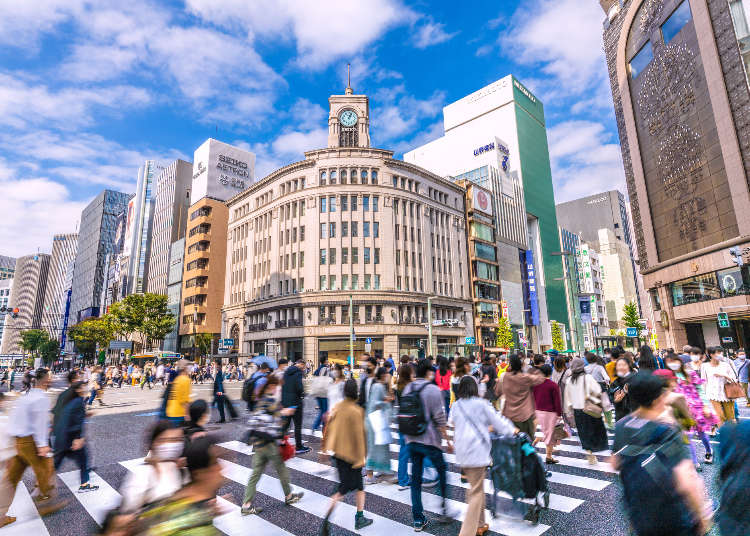
Japan's good public security record and excellent customer service have made it a top destination among many tourists. You might assume tourists only stick to sightseeing spots like Kyoto and traditional temples because of the unique Japanese experience they provide. Still, the truth is that ultra-modern areas like Ginza in Tokyo are popular among overseas visitors too!
Here, we'll dig deeper into Ginza's popularity by interviewing a few of our international friends about what things to do in Ginza that they found exciting and if they experienced any culture shock during their visit. (All statements are personal opinions.)
main image:2p2play / Shutterstock.com
1. Clean and tidy streets
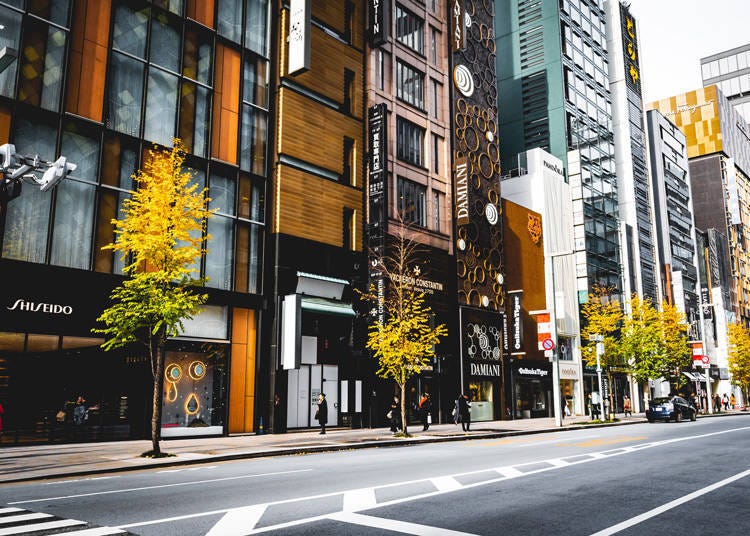
"I was surprised by how clean the streets were," remarked a Canadian man. "There wasn't a single rubbish bin in sight, yet you can't see rubbish anywhere on the ground. That's just amazing! Another thing that surprised me was the Kabuki-za building's exterior, with its fantastic design and lovely color combination. Just wonderful!"
A British woman added, "The huge amount of high-end department stores and specialty shops lining the streets was a pretty moving sight for me!"
Our non-Japanese interviewees were largely surprised by how clean the area is. This certainly speaks well of the Japanese people's etiquette about cleanliness!
Another aspect of Ginza that moved many visitors was the majestic view of rows upon rows of classy boutique stores in beautiful and historical buildings. Even walking down the streets of Ginza can be a pleasure, and this activity is enjoyed by so many, it has earned itself the nickname "ginbura," which means Ginza-stroll.
2. High End and Cheap Chains on the Same Street?!

"The classiness of the place did surprise me at first, but I got tired of the glitz pretty quickly. My wife is an avid shopper, and she loved it, though," said a Canadian man.
An American man remarked, "I knew about the high-end luxury boutiques, but I wasn't expecting to see value brands like Uniqlo and GU situated right next to them. That was something surprising for me."
The activity most commonly associated with Ginza is, needless to say, shopping! With so many department stores and branded boutiques to explore, one day wouldn't be enough to investigate everything that caught your eye!
On the other hand, if shopping isn't your kind of thing, Ginza may very well become a town that you will tire of relatively quickly, as one of our interviewees mentioned. It's probably the same thing for residents too.
Although Ginza is more well-known for its classy feel, it has its fair share of shops featuring products with more down-to-earth prices, too, so shopping doesn't necessarily have to be costly here. Anyone who loves to shop will absolutely be able to find something within their budget in Ginza, despite appearances!
3. Pedestrian Paradise!
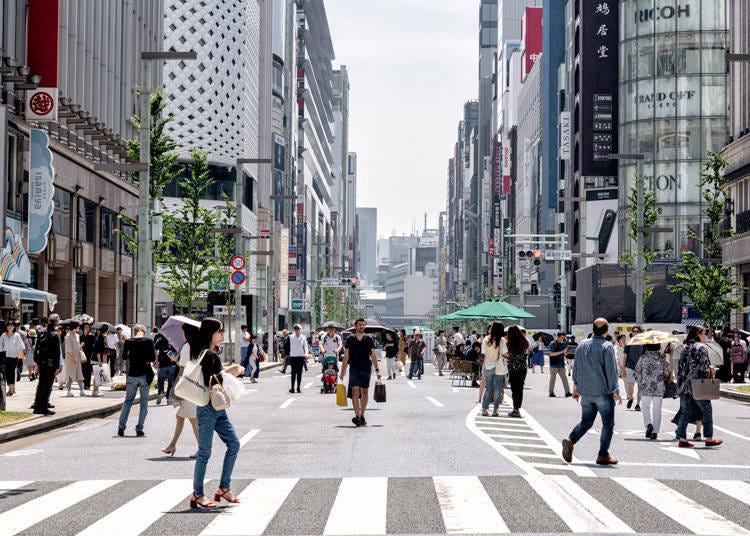
A British woman said, “There’s an event called Pedestrian Paradise, where roads are closed to cars, and pedestrians get to walk around on them during certain times. It was pretty special!”
“This makes the pathway so much wider for pedestrians and easier to get to places,” added a Canadian man.
“It’s easy to walk around in Ginza - even the back streets are pretty spacious,” said an American man.
The large-scale Pedestrian Paradise is a unique cultural aspect of Japanese city life, as roads are not typically closed to vehicles in Tokyo. Even local-born Japanese from other parts of the country get excited when they first see this activity in action!
As for the opinion that Ginza’s streets are pretty broad, this writer was surprised to hear that! Japan is, after all, notorious for its narrow roads and small spaces. However, towns and areas with a culture of holding “pedestrian paradise” events often have wider main streets than usual. Back roads, though? Certainly, an opinion this writer doesn’t quite share... Nevertheless, one has to admit that different people will perceive things differently - even and perhaps especially the concept of space!
In any case, a town that’s easy to walk around is a town that’s easy to explore, so wide streets are good news for anyone interested in looking at what Ginza has to offer.
4. Taxis and subways are not quite up to par...?
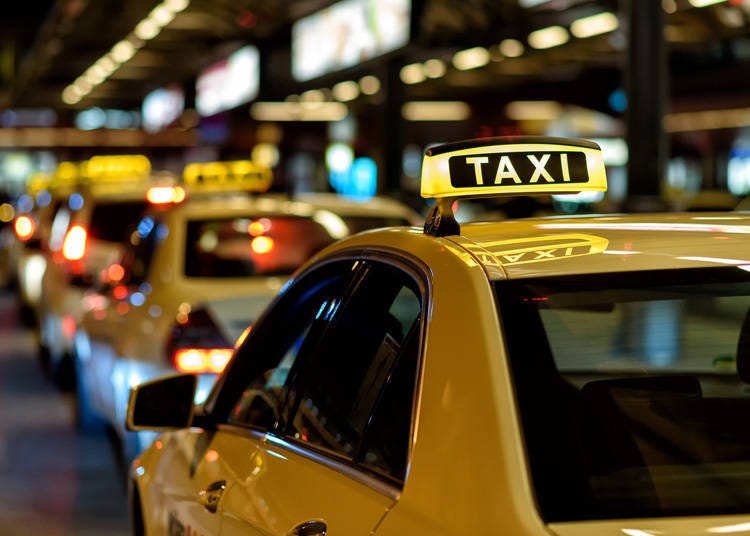
"I tried to flag a taxi, but nobody would stop for me! That was somewhat shocking. A friend later informed me that during certain time slots, taxis are only allowed to pick up passengers from designated taxi bays."
A British woman said, "How easy it was to get lost in the subway station surprised me. There were a lot of entrances, so getting into the station was a piece of cake, but trying to find the train I had to take was another matter altogether. I just couldn't find the right platform and had to check the signage so many times."
These are problems even Japanese people struggle with - difficulty finding an appropriate place to flag down taxis or being unable to get a cab because they all seem occupied! So friends from overseas, please know that we feel your pain and frustration in times like these.
In many other countries, hailing a taxi is usually the most convenient way to move around. However, because cabs may be more expensive in Japan than they are in other Asian countries, many tourists do find it challenging to justify frequent usage of this mode of transportation during their trips.
In which case, that leaves many people with the train service, but we all know how convoluted the stations and routes can get! Even if you don't get lost, you may end up walking around awkwardly inside the station, looking for the correct platform or the right way out. Train stations in Japan aren't always the most intuitive, after all, especially for tourists.
If these transportation pain points are addressed and improved, perhaps even more tourists would find visiting Japan an attractive option for their next trip!
5. One mango costs how much again?!
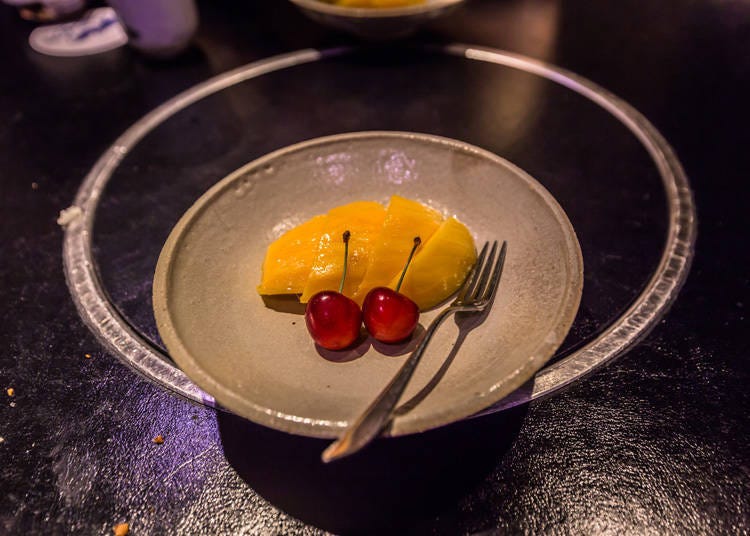
Finding food fuel in Ginza, a town well-known as a high-end shopping street, may seem like a recipe for budget disaster, but let's see what our international friends say about the food situation there.
According to an American man, "When you stroll along the back streets, you're bound to stumble upon old and historic buildings or small shops and restaurants, all lined up snugly alongside each other, which was a surprising sight for me. I have to say, one mango costing $55 threw me for a loop! In my home country, I can get one for just $1! That was quite a culture shock."
Many of our international friends find that the restaurants in Ginza are much more approachable than they initially thought. It looks like Ginza gets a passing grade as a tourist attraction regarding food and cuisine, then! Eateries are easily found in department stores, along main streets, and tucked away inside quaint back alleys, so finding one that suits your palate could be an adventure!
The mango story definitely left an impression on this writer, too. A "mango branding" phase swept through Japan recently, and the mango he saw was most probably one such branded mango. This highlights the different sense of values each country may have and is truly something that can only be experienced when going on a trip to another country!
6. Union of things old and new!
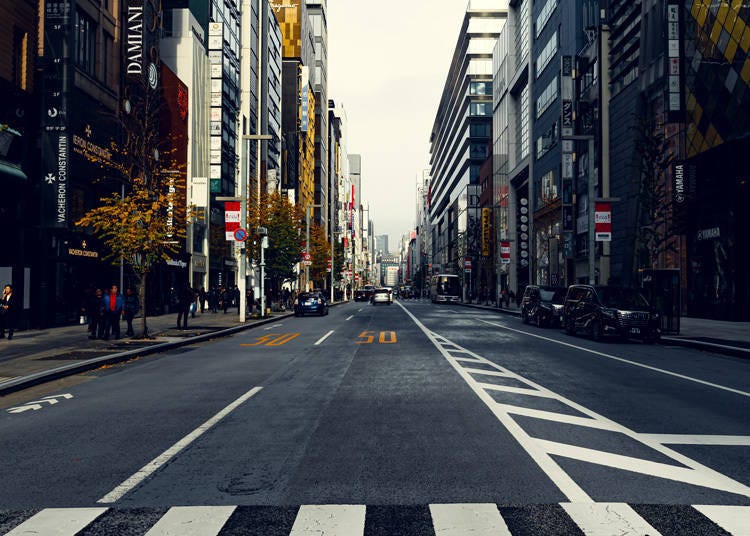
We've gone into quite a bit of detail about what foreign visitors liked about Ginza, but now let's hear their general thoughts about the thriving town itself.
"Lots of luxury shops from well-known international brands here. It feels like New York's 5th Avenue or London's Bond Street, down to the high-end hotels and vibrancy! That was something pretty surprising to me, you could say. Somehow, though, Ginza feels like a newer town than those places," said an American man.
Our American friend mentioned the newness of Ginza. This writer has never been to New York or London, so it's challenging to compare. Still, I believe he meant that Ginza is quick to absorb new trends and cultures, giving it an ever-changing appearance.
From old and historic buildings like Kabuki-za to ultra-trendy shopping streets, discount shops, and cozy back street restaurants, because the locals here are not caught up in pursuing the fixed concept of "nothing but branded goods," Ginza has been allowed to develop freely in organic ways.
The result? A multifaceted town that continually reinvents itself and keeps its shine by subtly and harmoniously combining the old and the new.
Ginza - a town to be enjoyed now and into the future
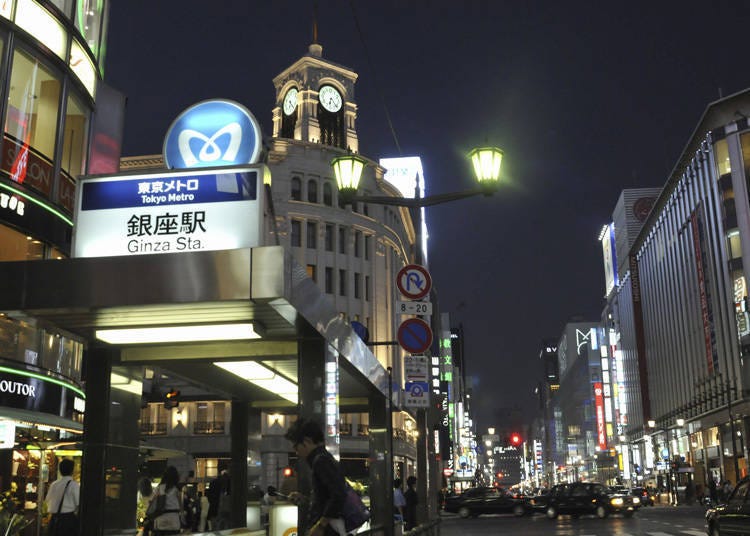
Although Ginza certainly does have room for improvement in terms of giving visitors better support, such as its taxi and subway system, we are confident you'll still be able to enjoy the unique atmosphere in this town that continues to grow and expand quickly now and into the future.
Interviewed and written by Dali Corporation. English translation by Huimin Pan.
- Area
- Category
*Prices and options mentioned are subject to change.
*Unless stated otherwise, all prices include tax.
Popular Tours & Activitiess
Recommended places for you
-

TOKYO SKYTREE®
Landmarks
Ryogoku / TOKYO SKYTREE(R)
-

The Imperial Palace
Other Architecture
Tokyo Station
-

Tokyo Metropolitan Government
Landmarks
Shinjuku
-

The Tokyo Station Marunouchi Building
Landmarks
Tokyo Station
-

Tsukiji Outer Market
Old Towns (Shitamachi)
Tsukiji
-

Naritasan Shinshoji Temple
Temples
Narita
-

How to Get Don Quijote's Exclusive 2025-2026 Winter Gift (+Tax-Free Savings)
-

New in Ginza! Air BicCamera Ginza Opens with a Faster, More Convenient Shopping Experience
by: Guest Contributor
-

Strawberries, Style, and Tokyo’s Coolest Neighborhood: Winter Afternoon Tea in Kichijoji
by: Guest Contributor
-

Japan’s Shinkansen Is About to Change Travel in an Unexpected Way
by: Guest Contributor
-

Jujutsu Kaisen Takes Over JR East With a Wrapped Shinkansen This Winter
by: Guest Contributor
-
Ad

Complete Guide to Ueno's National Museum of Nature and Science, the Perfect Place to Visit on Rainy Days or With Children
Inspiration for Accommodations
-

Enjoy Mt. Fuji from the Comfort of Your Room! Recommended Ryokan with Mt. Fuji View
-

Stay Near the Cherry Blossoms! Hotels for Cherry Blossom Viewing in Tokyo
-

Family-Friendly Hotels with Free Shuttle to Disneyland: Convenient Access for a Magical Stay
-

Top Ranked Hakone Hotels with Mt. Fuji View: Enjoy Stunning Scenery from Your Private Space
-

Convenient Tokyo Hotels with Airport Shuttle: Ideal for Families and Heavy Luggage
-

Stunning Tokyo Tower View Hotels: Enjoy Spectacular Scenery from Your Private Space
-

Convenient Asakusa Hotels with Kitchens: Ideal for Extended Family Visits
-

Experience Luxury: Hakone's 10 Best Five-Star Accommodations
-

Enjoy Mt. Fuji Autumn Leaves! Top Hotels Near the Popular Autumn Leaves Corridor
-

Experience Hakone Fall Foliage from Your Room with Stunning Views
-

Healthcare in Japan for Tourists: What to Do When You Get Sick or Injured in Japan
-

Tokyo Tourist Attractions: 6 Popular Places to Visit Around Shinjuku!
-

Shibuya Area Guide: Travel Essentials & 38 Best Spots for Shopping, Dining & Sightseeing
-

Tokyo's Top 25 Landmarks on Instagram!
by: Lucio Maurizi
-

Spending time in the modern city. Let's take a look around Roppongi!
-

6 Surprisingly Cheap Things in Japan
- #best ramen tokyo
- #what to buy in ameyoko
- #what to bring to japan
- #new years in tokyo
- #best izakaya shinjuku
- #things to do tokyo
- #japanese nail trends
- #what to do in odaiba
- #onsen tattoo friendly tokyo
- #daiso
- #best sushi ginza
- #japanese convenience store snacks
- #best yakiniku shibuya
- #japanese fashion culture
- #best japanese soft drinks












